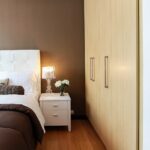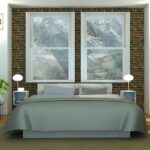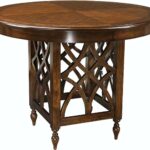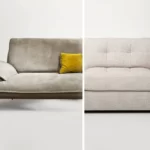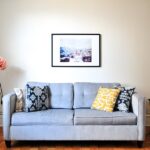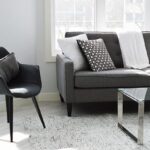Noisy neighbors, living in a densely populated area where the sound of honking cars is common, and the everyday hustle and bustle of city life can all have an impact on how well you sleep at night. To get a better night’s sleep, you’re probably wondering how to soundproof a bedroom.
To soundproof a bedroom: use weather stripping and a door sweep, fill in the space under the door, rearrange the room, apply curtains that capture sound and…
For more information, keep reading.
Table of Contents
How To Soundproof A Bedroom?
Use Weather Stripping & A Door Sweep
The bedroom door is a significant point of entry and exit for sound, I discovered during this entire soundproofing process. Dealing with the door might therefore be the most crucial action.
It’s easy for air to pass through a door’s cracks, as well as sound waves.
Installing a reliable door sweep was my first action.
These are incredibly affordable and work admirably. It appears to be incredibly durable and is very simple to install.
To stop those additional cracks from letting sound through, I also added some weather stripping seal tape around the door’s perimeter.
Fill In The Space Under The Door
You’ll be tossing and turning while being forced to hear every joke on the talk show your spouse is watching downstairs because sound can enter through the gap beneath your bedroom door. Attach rubber weatherstripping to the bottom of the door to close the gap.
Rearrange The Room
It’s not always necessary to spend a lot of money on soundproofing. In fact, you can take action to reduce bedroom noise without making any purchases at all. Occasionally, all it takes is rearranging the furniture with the goal of absorbing sound and preventing it from reaching your ears. Moving a large bookcase or dresser to a hallway back wall or an exterior wall can be a useful tactic for noise reduction. See more about How To Arrange A 10×11 Bedroom Perfectly?
Apply Curtains That Capture Sound
You get two benefits when you cover windows with soundproof curtains: an attractive, soothing decorative touch and effective soundproofing to block the noise of traffic, sirens, and loud pedestrians.
Wall Up The Sound
Wallpaper is making a comeback, and this time, it’s bringing something a little bit special. As it turns out, some wallpapers can reduce noise. Thick polyethylene foam is used to create soundproof wallpaper, which muffles noises and vibrations, including your neighbor’s buzzsaw snores from the apartment across the hall.
Peaceful Paneling
A simple and efficient way to absorb noise inside the room and reduce the amount of sound that enters is to affix some acoustic foam paneling to one or more of your bedroom walls. You can have some fun with the project because there are many different textures and colors of panels available. Then, those unwelcome noises may be a little less annoying when your neighbor revs his Harley first thing in the morning or your child practices the cello late at night.
Give The Door Some Weight
The door is something I’m emphasizing a lot because for me, it was the source of a lot of the issues. This step isn’t as important if you’re more worried about sound coming in from above, below, or the outside and traveling in those directions.
But for a lot of people, soundproofing the door as fully as possible will make a big difference. It did for me.
It is best to completely replace your door with a solid wood door. It’s likely that your bedroom is hollow-core style rather than solid.
Consider yourself lucky if your older home already has a sturdy door.
A solid wood door will typically cost at least $200 but may be much more. Because I wanted to add soundproofing to other areas of the room as well, I decided against spending that money.
There are steps you can take to give your door more mass if you don’t already have one or are unable to afford one. You can attach some drywall or MDF board to the door, though it might not look attractive.
This thickens and adds weight, which can significantly reduce sound leakage.
A weighted blanket or fiberglass panel are other options, but for me, simply hanging some inexpensive MDF board that was simple to install worked pretty well.
Seal The Windows
I also used the rubber weather stripping that was left over from the door on the window because I had some left over.
I wanted to go the extra mile even though there aren’t any real cracks allowing air in from the outside. Did this one actually change anything?
I’m not sure why, but it gave me a sense of accomplishment.
This step is going to be crucial if you do notice any kind of draft around your windows.
Sound is present if even a small amount of air is entering. The sound will be muffled by weatherstripping, and as an added benefit, the draft will be eliminated.
Sound Attenuation Through Floors
The noises that floors make can be grating, ranging from stomping feet to shrill squeaks. Whether your floor is made of wood or tile, you should spend money on a cover that acts as a soundproofing barrier.
This specific underlayment is invisible with the highest sound quality control, suitable for tile floors and stone-laying environments. To lessen the impact of walking noises, you should also think about investing in thicker carpets.
Limiting Ceiling Noise
Your bedroom’s location will determine whether the noise is coming from above or below. Reduced airborne noise, such as the sound of a TV playing, or impact noise, such as the pitter-patter of little feet, is beneficial in this situation.
Suspend Some Acoustic Foam
I had just mentioned how my curtains had improved the aesthetic of my bedroom, but this next step may have somewhat toned it down. You might not have wanted a recording studio vibe, but hanging acoustic foam on the walls throughout my bedroom did.
Having said that, I am aware that acoustic foam can be used in a more creative way to actually add some style, but I simply lack the necessary skills. With this stuff, you can experiment with colors, patterns, and shapes.
I’m not particularly creative, and I didn’t want to exert myself that much, but I can assure you that it can be done. You can find inspiration and design/layout ideas on Pinterest.
The ability of acoustic foam to block sound is not particularly effective. Instead, the main goal of this step is to absorb sound to prevent it from escaping.
This is excellent if you enjoy watching television or listening to music at a reasonable volume while other family members are trying to fall asleep.
If you know what I mean, it’s also fairly effective at preventing specific bedroom sounds from being broadcast to the rest of the house.
Soundproofing: What Is It?
If there is excessive noise around you, soundproofing your house or apartment might be the logical solution. Soundproofing is a technique that employs acoustic treatment to reflect, suppress, diffuse, and absorb noise or sound coming from a specific source. This can be done, among other things, by using double-glazed windows to keep outside noise from entering the building and various forms of insulation.
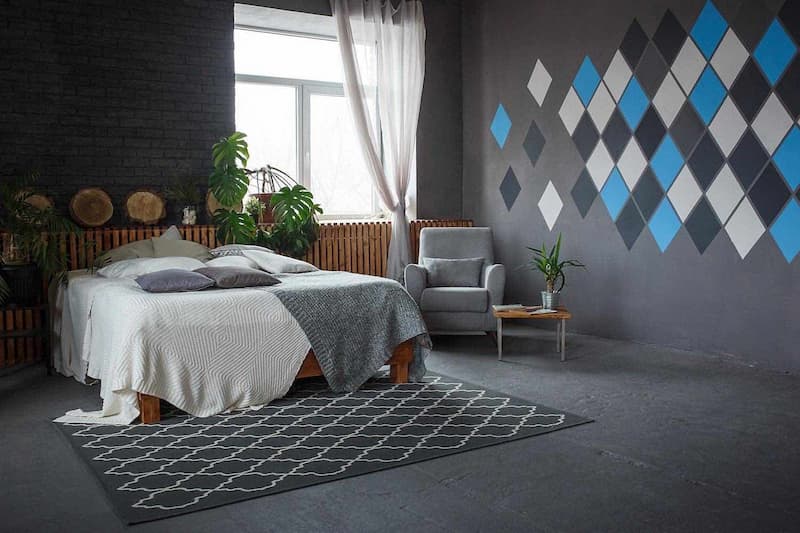
Why Should I Soundproof My Bedroom?
The good news is that you actually have some control over the noise that enters and leaves your room. You can quickly enjoy the tranquility of silence with a few soundproofing materials.
If you’re unsure of how soundproofing could help you, we can assure you that there are countless benefits. Whether you like them or not, you have no control over the noise your neighbors decide to make. You might find yourself putting earplugs in your ears on restless nights due to loud parties or music. You’ll get the peace you deserve when you soundproof your bedroom.
You can live comfortably without drawing unwanted attention to yourself if you soundproof your bedroom. You can enjoy all of your noises at your level of comfort, whether you have a passion for loud music or prefer to practice your guitar in peace. See more about How To Divide A Room With A Temporary Wall?
How Can You Soundproof House Or Apartment?
With all the noise going on around you, it’s difficult to enjoy some peace and quiet at home or in an apartment. Soundproofing the walls is one method for promoting restful sleep. The noise vibrations can shake your door, windows, and even glassware. Here are some recommendations for soundproofing your entire home after that.
Hanging Door Curtains
Installing blackout curtains inside your door can help reduce noise that enters your entryway if you live in an apartment and can constantly hear voices in the hallway. When you are inside, draw them in to block out the sounds coming from your neighbors.
Weatherproofing The Door
As previously mentioned, sealing any gaps in your front door is another method you can use to muffle noise inside your house. The threshold gap can be completely sealed by mounting a door sweep at the bottom of door frames, particularly one with this substantial rubber strip. Not only will this keep the sound at bay, but it can also prevent dust, drafts, and critters from entering your home.
Installing Extra Drywall
Sound usually produces a vibration that reverberates. Using a bulky, dense material that can keep them at bay is the best way to stop the sound waves. One of the best ways to dampen the sound vibrations is to add another layer of drywall to the wall. Caulk can aid in the reduction of outside noise by being applied in the gaps between drywall sheets. To muffle noises, use acoustical caulk that is about 3/8 inch thick. When finished, extend electrical outlets for easy access, refinish the drywall you installed on an existing wall, and paint it.
Installing Acoustic Panels
Installing acoustic panels to absorb sound before it bounces off the walls and ceilings is another method for soundproofing a room’s walls. This is usually installed in a music room, home theater room, or a room similar to those, but if you want to lower the noise, you can install it wherever you like.
The Bottom Line
That’s great up to a point, but if you don’t eventually stop when it’s “good enough,” I believe you could easily go a little bit crazy.” I’m aware that for some of you, completing this step will be the most challenging.
There has never been a better day than today to transform your room into a sanctuary.
But hey, if you do continue and have any recommendations for me that are simple to implement and aren’t outrageously expensive, I’d love to hear them! Please describe what you did and how well it worked.


